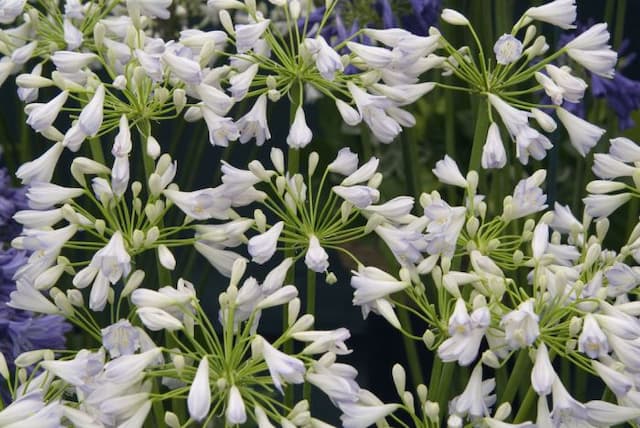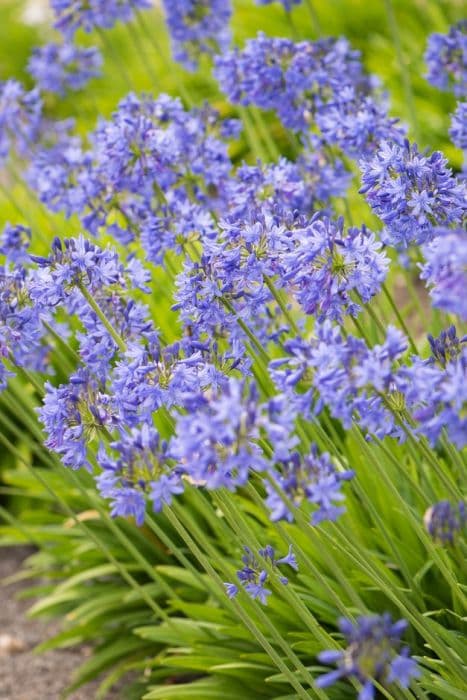African Lily Agapanthus 'Black Pantha' (PBR)

ABOUT
The Agapanthus 'Black Pantha', commonly known as the African Lily or Lily of the Nile, is a striking perennial known for its dark, lush foliage and showy blooms. The leaves of this plant are long and strap-shaped, emanating from the base in a dense clump. They have a glossy appearance and are deep green in color, which creates an eye-catching contrast against the flowers. The African Lily is celebrated for its spectacular flower clusters, which burst forth on tall, upright stems. The flowers are trumpet-shaped and come together in large, rounded clusters known as umbels. The blooms of the 'Black Pantha' are particularly dramatic, showcasing a deep violet-blue hue that can appear almost black in certain lightings. Each flower petal typically has a darker, central stripe that accentuates the richness of the color. Adding to the appeal of the Agapanthus 'Black Pantha' are the prominent stamens that extend beyond the petals, giving the flowers a starburst-like appearance. These blooms are not only visually stunning but also attract a variety of pollinators, including bees and butterflies. The overall impression of the African Lily 'Black Pantha' is one of bold elegance and vivid color. Its lush, contrasting foliage and sumptuous blooms make it a prized addition to any garden where it can be used to create dramatic borders or as a centerpiece in garden beds and containers.
About this plant
 Names
NamesFamily
Amaryllidaceae
Synonyms
African Lily, Lily of the Nile, Love Flower
Common names
Agapanthus 'Black Pantha' (PBR).
 Toxicity
ToxicityTo humans
The Lily of the Nile is not considered highly toxic to humans, but it does contain compounds that can cause gastrointestinal upset if ingested. Symptoms of poisoning can include nausea, vomiting, and diarrhea. It is important to avoid ingesting any part of this plant.
To pets
For pets, the Lily of the Nile can be more problematic. It is toxic to cats and dogs if ingested, potentially causing symptoms such as vomiting, diarrhea, drooling, lethargy, and nausea. Severe poisoning could lead to tremors or cardiac issues, though this is rare. It is advisable to keep pets away from this plant to prevent any accidental ingestion.
 Characteristics
CharacteristicsLife cycle
Perennials
Foliage type
Evergreen
Color of leaves
Green
Flower color
Dark blue
Height
2 feet (60 cm)
Spread
2 feet (60 cm)
Plant type
Bulb
Hardiness zones
8
Native area
South Africa
Benefits
 General Benefits
General Benefits- Ornamental Appeal: Features striking dark blue to purple flowers on tall stems, adding a dramatic visual element to gardens and landscapes.
- Drought Tolerance: Once established, it is quite drought-resistant, making it suitable for water-wise gardens.
- Low Maintenance: Requires minimal care beyond occasional watering and deadheading, ideal for gardeners looking for low-maintenance plants.
- Long Blooming Season: Produces blooms from late spring to summer, providing a lengthy display of color.
- Border and Container Gardening: Can be used effectively in borders and as a focal point in container arrangements.
- Attracts Wildlife: The blooms can attract beneficial pollinators like bees and butterflies to the garden.
- Clumping Habit: Grows in clumps that can be easily divided to propagate new plants and control growth.
 Medical Properties
Medical PropertiesThis plant is not used for medical purposes.
 Air-purifying Qualities
Air-purifying QualitiesThis plant is not specifically known for air purifying qualities.
 Other Uses
Other Uses- As a natural dye: The flowers of the Agapanthus can be used to create a blue or purple dye for textiles and crafts.
- Photography subjects: Their striking blooms make Agapanthus great subjects for botanical photography and art.
- Wedding decor: The elegant flowers can be used in wedding bouquets or as table centerpieces for special occasions.
- Edging for pathways: Planting Agapanthus along pathways provides a neat, decorative border that guides visitors through a garden.
- Ink production: The deep blue coloration of the flowers may be used to produce natural inks for drawing or writing.
- Teaching tool: Agapanthus can be used in schools or educational programs to teach students about plant growth, pollination, and bulb propagation.
- Culinary garnish: Although not common, the blooms can occasionally adorn food dishes as an exotic, non-toxic garnish.
- Erosion control: Agapanthus plants have thick roots that can help to prevent soil erosion on sloped areas.
- Floral arrangements: The long-lasting flowers are ideal for cut floral arrangements, adding height and color to bouquets.
- Garden themes: Agapanthus 'Black Pantha' can be used to create a 'black garden' theme with other dark-flowered or foliaged plants.
Interesting Facts
 Feng Shui
Feng ShuiThe African Lily is not used in Feng Shui practice.
 Zodiac Sign Compitability
Zodiac Sign CompitabilityThe African Lily is not used in astrology practice.
 Plant Symbolism
Plant Symbolism- Love Letters: Agapanthus, commonly known as African Lily, is often associated with love and is believed to symbolize love letters or messages.
- Beauty: With its striking deep blue or violet flowers, African Lily represents beauty and attention to aesthetics.
- Survival: As a plant that thrives in a variety of conditions, African Lily can symbolize survival and adaptability.
 Water
WaterLily of the Nile prefers consistent moisture, especially during its active growing season in spring and summer. Water the plant deeply until the soil is saturated but not waterlogged, then allow the top inch of soil to dry out before watering again. Typically, this plant will need about 1 gallon of water per week, but this may vary depending on climate and soil conditions. Reduce watering in the fall and further in winter when the plant is dormant, providing just enough to keep the soil from drying out completely.
 Light
LightLily of the Nile thrives in full sun to partial shade. The ideal spot for this plant is an area where it receives at least six hours of sunlight daily. However, in extremely hot climates, it benefits from some afternoon shade to prevent scorching.
 Temperature
TemperatureLily of the Nile grows best in temperatures between 60 and 80 degrees Fahrenheit. It can tolerate cooler nights and short periods of colder weather but should be protected if temperatures are consistently dropping below 50 degrees Fahrenheit. The plant is hardy and can survive brief exposures to temperatures as low as 30 degrees Fahrenheit, but it cannot withstand prolonged freezing conditions.
 Pruning
PruningLily of the Nile benefits from pruning to remove spent flower stalks and to tidy up any dead or damaged foliage. Prune immediately after flowering to encourage a secondary bloom and to maintain a compact shape. Cut the spent flower stalks down to the base. General pruning and tidying up can be done in early spring or after flowering.
 Cleaning
CleaningAs needed
 Soil
SoilAfrican Lily thrives in a well-draining soil mix with compost or manure, ensuring proper nutrition. It prefers a slightly acidic to neutral pH, around 6.0 to 7.0, for optimal growth.
 Repotting
RepottingAfrican Lily should be repotted every 2 to 3 years to refresh the soil and provide space for expanding roots.
 Humidity & Misting
Humidity & MistingAfrican Lily does well in average humidity conditions; it does not require any special humidity levels to thrive.
 Suitable locations
Suitable locationsIndoor
Place African Lily in bright, indirect light and keep the soil moist.
Outdoor
Full sun to partial shade, well-draining soil, protect from freezing.
Hardiness zone
African Lily is suitable for 8-11 USDA hardiness zones.
 Life cycle
Life cycleThe life of the African Lily 'Black Pantha' begins with seed germination, where conditions such as warmth and moisture trigger the development of a new plant. Following germination, the seedling stage is characterized by the emergence of the first true leaves and root system development. As the plant enters the vegetative stage, it produces robust, strappy foliage and strengthens its root structure, preparing for future flowering. During the flowering stage, typically in summer, the African Lily 'Black Pantha' produces tall, striking flower stalks with deep blue to purple bloom clusters, which are attractive to pollinators. After pollination, if successful, seeds are developed allowing for the dispersal and continuation of the species. Post-blooming, the plant enters a period of dormancy, especially in cooler climates, where it conserves energy for the next growing season.
 Propogation
PropogationPropogation time
Spring-Early Summer
The ideal time to propagate Agapanthus 'Black Pantha', commonly known as African Lily, is during late winter or early spring before new growth begins. The most popular method of propagation for African Lily is division. To propagate by division, carefully lift the parent plant from the ground after the flowering season has ended and it has begun to go dormant. Gently separate the clump into smaller sections, each with a portion of the root system and several growth points or shoots. These sections can then be planted into well-drained soil and watered in. Ensure each new plant has enough space to grow, usually about 18 to 24 inches (approximately 45 to 60 centimeters) apart, to allow for proper growth and air circulation. With minimal aftercare, the new plants typically establish quickly, resulting in additional flowering specimens for the garden.







![African lily [Brilliant Blue]](/_next/image?url=https%3A%2F%2Fplants-admin.emdemapps.com%2Fimages%2Fplants%2F%2Fimages%2F604b5e3c28e2b.png&w=640&q=75)

